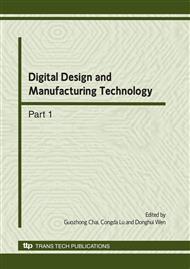p.237
p.242
p.247
p.252
p.257
p.262
p.267
p.272
p.277
New Characteristics of Inverse Analysis Method and its Application in Sheet Metal Formability Prediction
Abstract:
Information of initial flat blank and final workpiece is prerequisite and satisfactory blank configuration and thickness distribution can be obtained, which is very important at the preliminary design stage. The theory and improvements of inverse analysis method of sheet metal forming based on deformation theory of plasticity is explored. In order to take into account the bending effects, this approach with CST membrane element and DKT6 plate bending element superposed to obtain the DKT12 shell element is fully introduced. An ideal reverse deformation method is implemented to improve the initial solution obtained by radical length development method. Application to a square box deep drawing case is presented with emphasis on the efficiency and usefulness of the proposed improved methods.
Info:
Periodical:
Pages:
257-261
Citation:
Online since:
March 2010
Authors:
Price:
Сopyright:
© 2010 Trans Tech Publications Ltd. All Rights Reserved
Share:
Citation:


